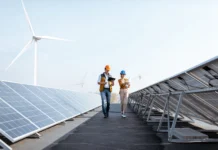By Cara Bommarito, sustainability manager, RadTech
In early September, I had the great pleasure to attend PCI’s Coating, Trends and Technology conference (CTT) in Lombard, Illinois. The conference was a great experience. Held at a convenient location and lovely hotel, the conference delivered informative content, networking opportunities and, most importantly, stellar presentations. RadTech was fortunate enough to have four members present at CTT. Aside from being a strong presence in the UV/EB industry, they all have at least one other thing in common: They are all named Mike.
Their presentations all had some mention or focus on the well-known sustainable benefits of UV/EB technology. They also discuss how UV/EB technology helps streamline production, increase efficiency and save energy. Here are four short summaries on each of the UV/EB presentations given at CTT.
Michael J. Dvorchak, technical director, Dvorchak Enterprises LLC
UV Cure ‘Shark Skin Bio-Mimicking’ Antimicrobial Surfaces for Autonomous Vehicles?
The presentation looks at Shark Skin coating technology as it relates to the emerging autonomous vehicle (AV) market. The coating will be useful with AVs because of the antimicrobial properties the coating creates. In the future, when AVs will be shuttling many people around, it will be great to have surfaces that do not harbor bacteria. Another application for the technology is in aerospace. When used to coat airplanes and jet crafts, the coating is proven to reduce drag by 1%. This helps save tons of CO2 annually.
Michael R. Bonner, vice president, Engineering & Technology, Saint Claire Systems, Inc.
Borrowing from the Past: Is UV/EB Technology a Sustainable Solution to the Energy Crisis?
This presentation looks at the energy crisis during the 70s and how it applies to today’s energy crisis. The case study in the presentation has the best data. It looks at how switching a coil coating line from thermal oven to electron beam has a significant benefit. This conversion saved the coil coater a 98% reduction in energy. This was an important finding and a huge win in showing actual data behind the claims that the UV/EB industry contributes to energy savings. The presentation also discusses how this information could be important for the automotive industry.
Mike Knoblauch, president, Keyland Polymer Material Sciences, LLC
An Introduction to UV-Cured Solid Resins: Applications and Benefits
In this presentation, Knoblauch presented the benefits of UV powder coating technology. In addition to the known benefits promoted by UV/EB technology users, there is another very interesting sustainable benefit: Powder coatings do not use water in production. This provides huge water-saving benefits to users of this specific technology. Water is one of the most important resources on the planet. It is crucial to support conservation of water. When creating formulations with waterborne paint, the formulations also use precious water resources that cannot be reused. It also is very costly to ship liquid coatings because of the weight. Keyland’s presentation was an interesting approach to sustainability when thinking about the importance of water conservation.
Mike Higgins, director of sales, Phoseon Technology
Illuminating Production Dark Spots with LED
Higgins’ presentation was a problem-and-solution presentation. He specifically talked about how Phoseon is helping companies save energy and money. Phoseon LED curing lamps are solid-state electronic devices that are designed to last seven to 10 years in service without replaceable components. At the end of their life, more than 80% of the lamp can be recycled (similar to a computer or cell phone). These lamps consume 70 to 80% less energy while in use compared to traditional mercury UV or thermal-cure ovens. Finally, Phoseon LED curing lamps do not contain mercury, nor do they generate any ozone while in use. In summary, there is no more efficient or sustainable way to produce UV energy for curing than Phoseon LED.
I was so glad to be part of CTT and able to attend. It was nice to see firsthand what our members are doing for the UV/EB industry. I was very impressed with the many different elements of sustainability which were brought up during the presentations. The best part is there are even more Mikes in RadTech doing ground-breaking work in the UV/EB industry. At CTT, I had the pleasure of only seeing a few of the Mikes. I would love to hear more about all our members’ efforts in sustainability. To share your sustainability story, email me at cara@radtech.org.






